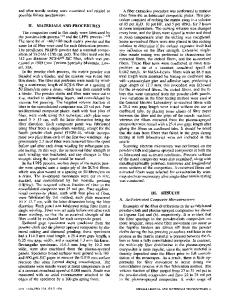Microstructures and Mechanical Properties of In-Situ Al 3 Ti/2024 Aluminum Matrix Composites Fabricated by Ultrasonic Tr
- PDF / 4,752,025 Bytes
- 11 Pages / 595.276 x 790.866 pts Page_size
- 17 Downloads / 359 Views
Microstructures and Mechanical Properties of In‑Situ Al3Ti/2024 Aluminum Matrix Composites Fabricated by Ultrasonic Treatment and Subsequent Squeeze Casting Gang Chen1 · Xusheng Chang1 · Jingxuan Zhang1 · Yu Jin1 · Cheng Sun2 · Qiang Chen3 · Zude Zhao3 Received: 16 March 2019 / Accepted: 23 July 2019 © The Korean Institute of Metals and Materials 2019
Abstract Squeeze casting is a near net shaping technology which is advantageous to refining the microstructures and improving the mechanical properties. In the present work, in-situ Al3Ti/2024 Aluminum matrix composites with different amount of Al3Ti reinforcements were successfully fabricated by ultrasonic treatment and subsequent squeeze casting. The effects of specific pressure and the amount of reinforcements on microstructures and mechanical properties were studied. The results show that when the specific pressure is increased from 0 to 150 MPa, the average grain sizes of α-Al matrix are decreased by 39.8%, and the yield strength and compressive strength are increased by 16.8% and 22.9%, respectively. However, severe segregations of eutectic structures were generated under an excessive specific pressure of 200 MPa, which also results in deterioration in the mechanical strength. The mass fraction of Al3Ti phases has significant influence on morphology of eutectic structures. When the mass fraction of Al3Ti phases is increased from 4 to 16 wt%, the eutectic structures was changed from continuous network to dispersed structures gradually. The compressive strength was increased from 611.2 to 712.0 MPa (increased by 16.5%), as the Al3Ti content increasing from 0 to 16 wt%. However, as the mass fraction of Al3Ti phases increased, the variation in the yield strength is not monotonically increasing. Keywords Ultrasonic treatment · Squeeze casting · Al3Ti/2024Al composites · Microstructures · Mechanical properties
1 Introduction Aluminum matrix composites (AMCs) have been widely used in aerospace, automobile, electronic products and militaries during the past several decades, due to the advantages of low density, high specific strength and specific rigidity, good dimensional stability and excellent wear resistance [1–4]. The aluminum-rich intermetallic phases, e.g. Al3Zr, Al3Ni and Al3Ti, have been recognized as promising reinforcements for AMCs because of their low density, high
* Qiang Chen [email protected] 1
School of Materials Science and Engineering, Harbin Institute of Technology, Weihai 264209, China
2
Department of Technology, John Deere (Tianjin) Works, Tianjin 300457, China
3
Center of Precision forming, Southwest Technology and Engineering Research Institute, Chongqing 400039, China
specific strength and excellent oxidation resistance at high temperatures [5, 6]. Al3Ti is the lightest Titanium–Aluminum intermetallic compound with a density of 3.3 g/cm3. The Al3Ti reinforcements formed by in-situ reaction lead to lower lattice mismatch, good wettability and clean interface between the reinforcements and Al matrix [7–13]. Squeez
Data Loading...











